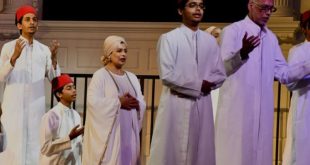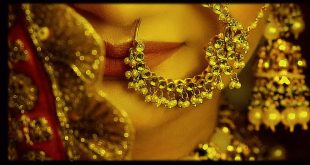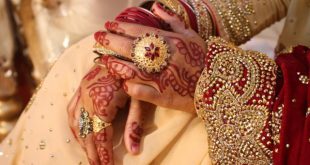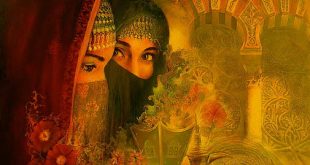The names of Moor females like those of Moor males are largely of Arab origin. Popular names for girls include Fātima (the name of the Prophet’s beloved daughter), Āyisha, Hafsa, Khadija and Zaynab (the names of the Prophet’s wives or Ummul Mūminīn ‘Mothers of the Believers’ as they are usually known by the faithful) Asma (The first Caliph Abu Bakr’s daughter and the Prophet’s sister-in-law), Salma (The Prophet’s aunt, wife of his uncle Hamza), Maryam (Mary, the mother of Jesus), Hanna (Anne, the mother of Mary) and Hājara (Hagar, the wife of Abraham and mother of Ishmael). We also not uncommonly come across names like Balqis (The Queen of Sheba), Zulaykha (The wife of the Egyptian courtier who attempted to seduce Joseph), Sumayya (a lady companion of the Prophet and the first martyr in Islam) and Zubayda (The consort of Caliph Hārūn Ar-Rashīd).
The name of the Prophet’s youngest daughter Fātima (Lit.The Weaner) is immensely popular among the Moors as it is among other Muslim peoples and very commonly precedes the proper names of girls just as Muhammad or Mohamad precedes those of boys. Yet another popular name among Moor women, Kulsum (in the eastern areas Kuldum) has evidently derived from Umm Kulthūm, another daughter of the Prophet. Zaynab which figures as the name of yet another daughter of the Prophet and two of his wives, namely, Zaynab bint Jahsh and Zaynab bint Khuzaima was apparently much loved by the Prophet as he himself renamed a woman previously known as Barrah by it (Bukhāri). Zaynab was evidently the name of a famous third century Queen of the Palmyrenes known as Zenobia who extended her little kingdom northeast of Damascus to include Egypt and was very popular among the Arab women of the Prophet’s time.
One also commonly comes across Arabic names like Asma ‘precious’, Āshiqā ‘sweetheart’, Bushra ‘good news’, Husna ‘beautiful’, Jamīla ‘pretty’, Fahīma ‘intelligent’, Fawziya ‘victorious’, Farhāna ‘cheerful’, Nabīla ‘noble’, Nafīsa ‘valuable’, Muhsina ‘chaste’, Razāna ‘modesty’, Rihāna ‘aromatic plant’, Safīna ‘cleanser’, Safiyya ‘pure’, Silmiya ‘peaceful’, Shamīla ‘virtue’, Zahra ‘flower’, Zulfa ‘dignity’ and Zīnat ‘ornament’. Besides these we find names of Persian origin similar to those borne by Indian Muslim women such as Firozā ‘torquoise’, Farzānah ‘wise’, Roshanā ‘light’, Sharmilā ‘shy’, Shahnāz ‘a musical note’ and Yasmin ‘jasmine’.
One may also come across among the older women names like Patima or Patuma instead of the Arabic Fātima and Pahima instead of Fahima. In the Eastern Province may be found names like Kadisā (as in Kadisā-Umma) which has derived from the Arabic Khadija and Zaynambu from the Arabic Zaynab. Such usages are quite old, and not just in the Eastern Province.We find in an 18th century Dutch Tombo a reference to a Moor woman named Seynaboe Natcha.
One may also come across more classical names like Shahrazad, the story-teller of the Arabian Nights, which is also of Persian origin. Other common names that suggest Hindustani influence include Fazmina, Rozāna, Rinōza, Sabrīna, Shabīna, Sharmila and Shazmina.
Moor women are also still known to bear compound names like Aynul Shamīla, Nūrul Zulfa and Zīnatul Qabīla. These names are replete with meaning and are rather grandiose, for instance, Aynul Shamīla literally means ‘eye of virtue’, Nūrul Zulfa ‘Light of Dignity’ and Zīnatul Qabīla ‘ornament of the tribe’. Names suffixed with Nisā (An Arabic term meaning ‘women’) are also not uncommon and one still comes across Moor women with names like Kairun-Nisā, Safrun-Nisā and Maharun-Nisā. The usage is evidently an old one. For instance, the Moghul Emperor Aurangzēb’s daughter was known as Zēb-un-Nisā or ‘Ornament of Women’. Such names are hardly if ever given to children nowadays. Moor women also not uncommonly bore names like Fathumutu, probably a compound formed of Fātima and the Tamil muttu ‘pearl’.
One often finds today that the name of the Prophet’s daughter Fatima often precedes the personal names of girls, but until fairly recent times it was Sitti that was commonly prefixed to the names of girls. Indeed, one still comes across plenty of Moor women, both young and old, bearing this name. The name is evidently of Arab origin and derives from the Arabic sitt ‘lady’ though we often find this term being used in Arabic for a married woman, the term for an unmarried young woman being ānisa. Nevertheless we also come across in Arabic the term sitti (probably derived from the aforementioned sitt) being used indiscriminately in the sense of ‘Madam’. That the term may have even figured in Arab personal names is suggested by the name of a woman named Sitt-al-Husn ‘Lady of Beauty’ occurring in the Alf Layla Wa Layla. Another common practice in the olden days was to precede names with Nūr ‘light’ such as Nūr Jezima, Nūr Huzaima and Nūr Zanūba.
The personal names of some women may also be suffixed with Bēgam, a Hindustani term of Turkish origin meaning ‘lady’ (being the feminine of the Turkish Bēg ‘chief’) such as for instance Rizna Bēgam, Sahida Bēgam and Sajida Bēgam. Bībī, another Hindustani term of Turkish or Persian origin meaning ‘lady or ‘wife’ was not uncommonly suffixed to the names of women of the older generation. In the Eastern areas, it commonly takes the form bīvi and one may still come across women with names like Laila Bīvi, Nazila Bīvi and Mariyam Bīvi. The usage though rare was not unknown even in Dutch times where we find in the Dutch Tombo for the Kalutara District the Moor female names Pier Biwie and Seijdoe Biwie and even one named Asa Biwie in Alutgama.
Umma, an Arabic term for ‘mother’ commonly followed the names of women in the not too distant past as is evident in the names of 19th century Muslim women given in Sameer’s work where we find names such as Hafsa Umma, Haniffa Umma and Umma Hany Umma. Indeed, names suffixed with –Umma such as Amīna Umma, Salīma Umma and Rushniya Umma are still borne by Moor women. We were also told that in Jaffna, the Moor women bore such Tamilicised names like Muttummā (Lit.Pearl-mother) and Tangammā (Gold-mother) though some had their origins in Arabic proper names such as Selayammā, from the Arabic Zulayha. These are said to have been pet names and not proper names. We were however told that in the Eastern Province, names suffixed with –ummā were given to girls when they were named in infancy and we may still come across women here with names like Yūsuppu Ravia Ummā and Kadisā- Ummā. Perhaps the earliest recorded instance of such a form occurs in a Dutch Tombo where we come across a female Moor name Oemo Naetja (Ummu Nāccā).
It is possible that such names have been influenced by the Arab tradition of calling women by their agnomen (kunya), that is to say, the mother of so-and-so by prefixing umm ‘mother’ to the proper names of their offspring such as for instance Umm Darda (The mother of Darda). Although it follows that such names could only be given to women who have had children, Margoliouth (1917) has shown that the practice of giving persons names after their children became so regular in Arabia that names of this kind (e.g.father of Zaid, mother of Amr) were even given to infants. Such a practice was even found in the early days of Islam, though very rarely, for in the Adab Al-Mufrad we are told that Alqamah was given the agnomen Abu Shibal even though he had no children. It is also possible however that the Moorish custom of suffixing names with umma may have been influenced by the Tamil custom of following the names of women with amma prevailing in certain areas. Such names appear to have been widespread among the Mukkuvar women of Batticaloa who bore names such as Muththamma, Kannammai and Valliyammai.
Another feminine name suffix formerly used by the Moor women of upcountry areas like Akurana, Nācciyā, is evidently from the rare Tamil honorific nāycci or nācciyār ‘lady’ ‘mistress’ (Winslow 1862). Such names were fairly common in the olden days. These included names like Zainambu Nāciyā, Fatumutu Nāciyā and Ummu Hani Nāciyā. Indeed, we were told that even in Jaffna, the Moor women commonly bore names such as Seynambu Nācciyā, Sultān Nācciya and Mīrā Nācciyā. In the Eastern areas however this usually took the form Nācci. Thus Hawwa Nācci, Kadīja Nācci and Zaynambu Nācci. This usage was far more common in the olden days, not only in the upcountry, or in the north or east, but also in the Western littoral (Kalutara District) as attested in the Dutch period records known as the Tombos where we find female Moor names like Aijza Naetja, Kadiza Naetja, Jeijneboe Naetja and Walkizi Naetja. Here the suffix Naetja (pronounced Nāccā) has been affixed to female names which are no doubt corruptions of the Arabic Āyisha, Khadija, Zainab and Balqis respectively, the first three being the names borne by the Prophet’s wives and the last being the popular Arabic name for the Queen of Sheba.
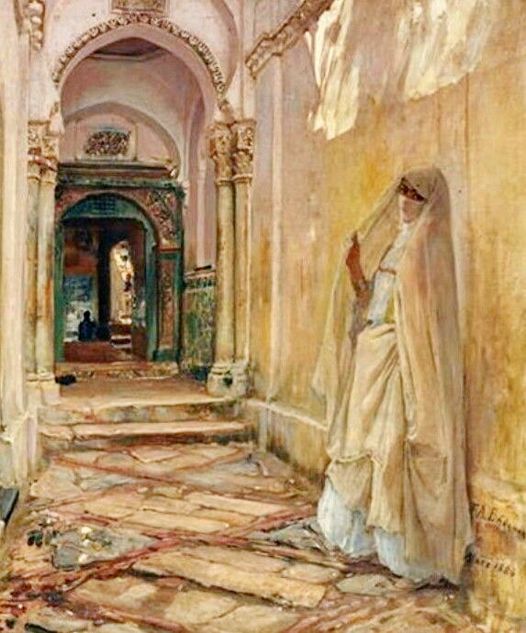
 Sri lanka Muslims Web Portal Diversity and Inclusiveness
Sri lanka Muslims Web Portal Diversity and Inclusiveness
